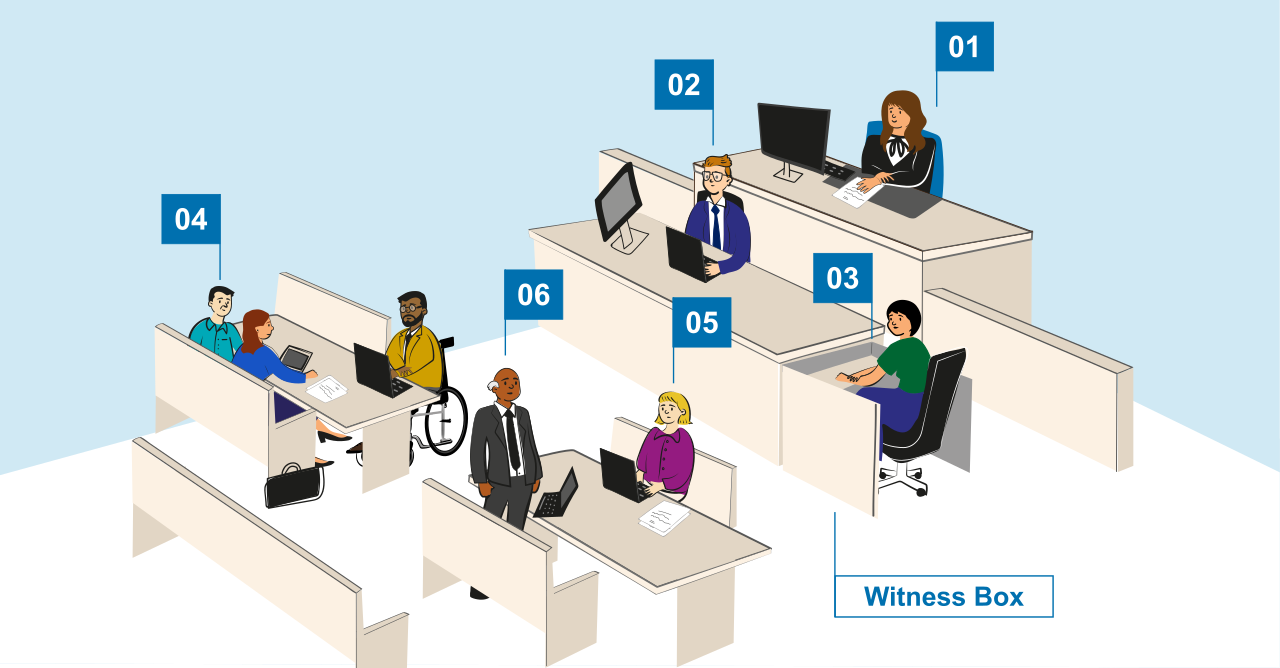Who to expect in the courtroom
Before you go to court, you might want to familiarise yourself with the courtroom layout and who will be in it. Below you can find some useful information on who you can expect in the courtroom

01 Judge
The Judge is in charge of your court hearing. They dress formally, and sit at their own bench at the top of the courtroom. The Judge enters and leaves the courtroom through a separate door near their bench.
01 County Registrar
A County Registrar is a Court official who has a number of quasi-judicial functions in the Circuit Court. They dress formally, and sit at their own bench at the top of the courtroom. The County Registrar enters and leaves the courtroom through a separate door near their bench
02 Court Registrar
The Court Registrar sits in front of the Judge/County Registrar. They assist the Judge/County Registrar with administrative matters and are in charge of court documents and evidence. It is the Court Registrar who administers the oath to witnesses and who will record the decision or outcome of the case.
03 Witness
The witness sits to one side of the judge and gives testimony in court. Either the claimant or respondent to a case may be called to the witness box to give testimony during the hearing. Other witnesses may also be called who can provide additional information to a case to help the Judge reach a decision.
04 Claimant and Respondent
The claimant (plaintiff) in a hearing is the person who started the Civil Law case. The respondent (defendant) is the person who has had a case started against them. They will sit at different sides of the courtroom. In many cases, they are legally represented by a solicitor or barrister, or both, who will speak to the court on their behalf.
In some cases, claimants and respondents may choose to represent themselves and speak directly to the court.
05 Solicitor
The solicitor will state the case for their client to the Judge/County Registrar and outline what decisions their client is looking for.
06 Barrister
In addition to a solicitor, either party may also seek representation from a barrister for their hearing. The barrister will face the judge and argue the case on behalf of their client.
07 Assistant to the Judge (not shown on illustration)
The Judge may have an assistant in court. They usually wear a black robe. In addition to other duties, the assistant to the Judge often announces the arrival and departure of the Judge from the courtroom (usually by saying ‘all rise’).
08 Others (not shown on illustration)
At any one time, you may find court officers, legal representatives, parties to other cases, and witnesses in the courtroom. Members of the public and press are generally allowed to attend civil court hearings also, except where the court directs otherwise or in certain types of cases, which are always held in private.
In some cases, claimants and respondents may choose to represent themselves and speak directly to the court, and may have reasonable assistance from another person (typically known as a ‘McKenzie Friend ’). For more information on the role of a McKenzie friend, please see our McKenzie friend page.

